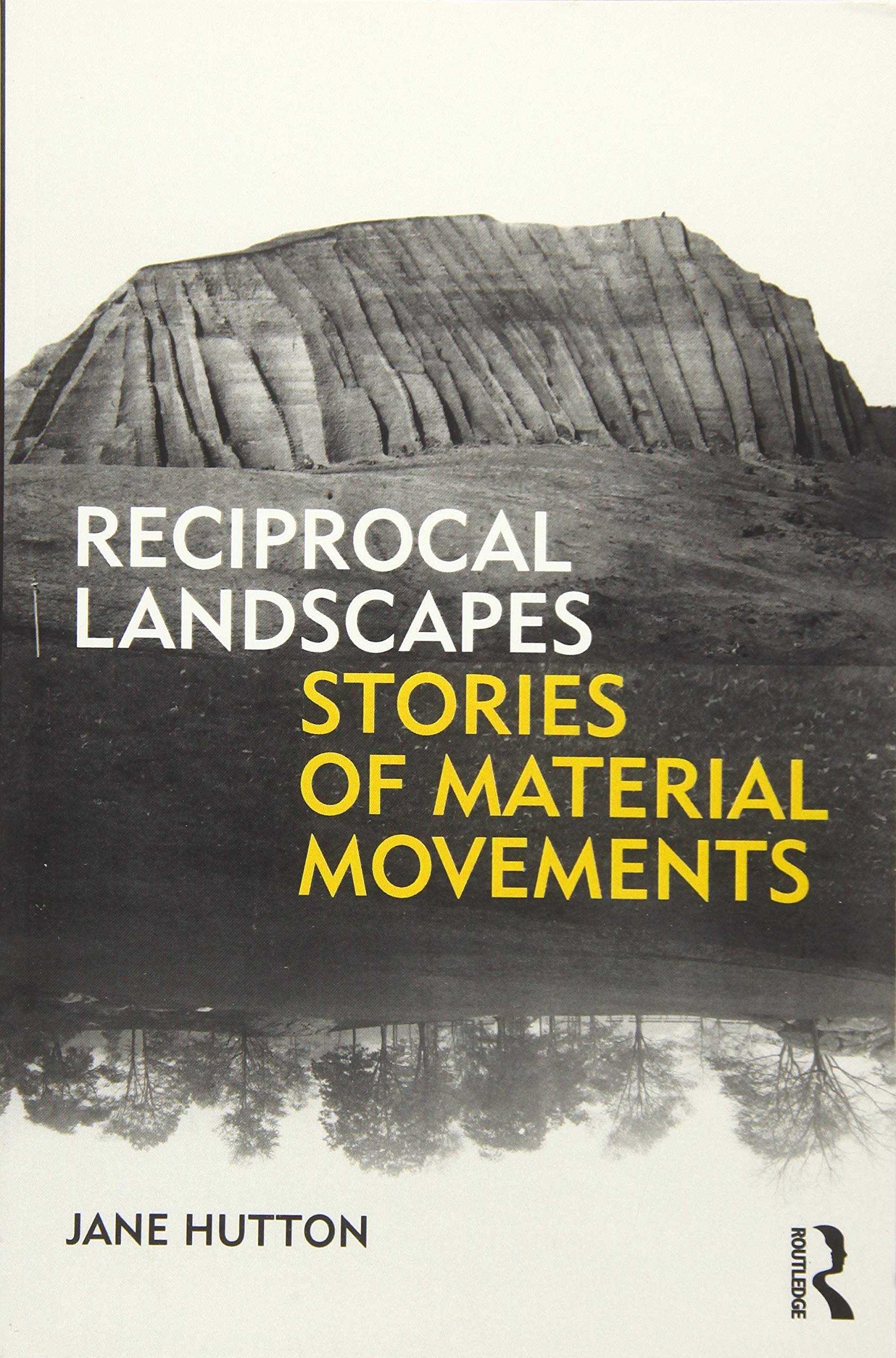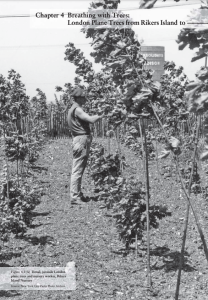Jane Hutton
Routledge, 2019

I started writing this review of Reciprocal Landscapes while an errant cargo ship found itself stuck in the Suez Canal, paralyzing billions of dollars in global trade and causing massive supply chain breakdowns. It felt like an appropriate backdrop to the book’s exploration of landscapes and labor rendered remote by the processes of material commodification. Hutton’s book presents five stories of global material flows—from sites of origin to sites of use in New York City designed landscapes starting with Central Park. The book starts out by framing “paired” landscapes of production (extraction) and consumption with earthworks artist Robert Smithson’s theory of “Nonsites” as a point of departure.1 The initial framing left me wondering about the complexities of the supply chain well beyond these binary spaces—origins to endpoints— but I soon realized that Hutton’s stories are much richer than the directness with which she initially draws her reader in. As she acknowledges, her stories show strong parallels to Michael Pollan’s The Omnivore’s Dilemma: A Natural History of Four Meals, but here food is replaced with materials used in construction and, unlike Pollan’s, they are not stories of shifting ethics but of capitalism’s shifting faces since the mid-nineteenth century. Yet like that of today’s food justice movement, Hutton’s message is a call to ethical action. Another recent book that traces a single material as a means to understand capitalism’s troubling binaries is Mimi Sheller’s Aluminum Dreams: The Making of Light Modernity (2014). Yet rather than attempt to write a global history of modernization through a single material as Sheller does, Hutton’s focus and method is more intimate—often using first-person analysis of landscapes of extraction and use—while still revealing the inequality and violence of global capitalism at its broadest scales.
While Hutton is a landscape architect and at times targets the architecture and building industries audience, the book presents material, industrial, labor, and landscape histories that far transcend this readership. Reciprocal Landscapes responds to and expands on literature in the area of New Materialism, which is focused on the agency and animacy of matter, creating links to authors such as Anna Lowenhaupt Tsing, Jane Bennett, and Karen Barad. Of landscape architects, she identifies a specific tension between a professional desire to sustain healthy human-nature relations and the lack of attention given to the often-violent aspects and aftermaths of material production.
Structure
After an introduction that provides Marxist frameworks of analysis and the aspirational ethics of “reciprocity,” citing Robin Wall Kimmerer, author of Braiding Sweetgrass: Indigenous Wisdom, Scientific Knowledge and the Teachings of Plants, each chapter traces a single material: guano extracted from the Chinchilla Islands in Peru for use as fertilizer in Central Park in the 1860s (Chapter 1), granite from Maine to pave Broadway in the 1890s (Chapter 2), structural steel from the blast furnaces of Pittsburgh to support Riverside Park in the 1930s (Chapter 3), London plane trees grown on Rikers Island by incarcerated workers and planted on 7th Avenue in Harlem in the 1950s (Chapter 4), and ipe, a tropical hardwood, from the Amazonian forests in northern Brazil to the High Line in the 2000s (Chapter 5). The book culminates with a short conclusion briefly tying the five stories together and returning to the theme of reciprocity. While she does not directly cite Cedric Robinson’s theories of Racial Capitalism, Hutton’s stories sustain an important focus on the racialized processes of value extraction and the ecological imperialism so integral to understanding the Western colonial project. Enslaved, unpaid, coerced, and unjust labor practices are as essential to the stories as the landscapes “here” and “elsewhere.” Hutton traces these stories of material extraction and labor exploitation that loosely make up a history of dynamic political and economic contexts.

Figure 1. Five material movements. Reciprocal Landscapes, 12-13.
The chapters are presented as five discrete stories following respective material movements. Each can be read in isolation and includes the notes and bibliography at the culmination of the chapter, which makes assigning chapters easy as an instructor. Reading the book in its totality presents diverse insights into material ethics and ways forward, so it would have been helpful at times to draw connections across stories rather than save a synopsis of connections for the short epilogue. Admittedly I had read many of these stories in different sources during the book’s development (listed in the frontmatter) so my assessment is the discreteness is likely both a publisher’s choice for use in the classroom and a result of consolidating previously standalone publications.
Each chapter has clear and compelling subsection titles in a general rhythm that describes: material formation in geologic and/or biological timescales and across physical scales from the cellular to the tectonic; conditions of the origin landscapes; processes of extraction (or production in Pittsburgh’s case); how the material facilitates concentrations of cultural capital in New York City; and the afterlife of both landscapes (origin and use) and the implications of their histories for the present. The book is elegant in its simple design, and the black and white figures are well curated and include archival documents, photographs of giving and receiving landscapes and the people that Hutton meets along the way. At times, I wished there were images that would aid in understanding, such as in the section “where granite went,” where Hutton includes the outside of the binder labeled as such sitting on the historical society desk as an archival cache, yet does not include the maps of “granitic dissemination” or the endpoints of granite all over the United States that she describes the archive as containing (71–72).
Methods + Style
Hutton’s research was conducted using an array of research methods from the archival to the ethnographic to firsthand field study. She oscillates between writing in third person and first, asserting her own voice as she brings the reader on her journeys to explore these binary landscapes. Her first-person writing of distant landscapes of extraction is in a style reminiscent of John McPhee, offering sensate descriptions of details such as the deafening drone of forest life heard from her hammock at night in Belém, Brazil (196). She introduces us to the characters she meets along the way—local historians and archivists, field scientists and activists, including Jorge Tarazona Paredes, the lone resident of Isla Chincha Norte, and Robert Zappala, former NYC Parks Department Rikers Island Nursery employee. After the first transition into the first person, which was a bit startling, I quickly got used to and even looked forward to the rhythms of these shifts.

Figure 2. Former hospital with Jorge Tarazona Paredes and Jhuneor Paitan Ñahui in foreground, North Chincha Island, 2014. Reciprocal Landscapes, 42.
Stories
The stories about guano, London Plane trees, and steel are the three most compelling. The material deposit of guano, and its horrific process of extraction by enslaved Chinese workers, supplied voracious southern plantation markets as a commodity. The alleged “strength” of guano as fertilizer was used to negate the work of Black slaves in growing and processing plantation “yields.” This “material flow,” ultimately specified for use in Central Park, provides a whole new perspective on this long studied Olmstedian icon. Part of this fresh analysis includes explaining how the park was implicated into processes of urban waste and globalized nutrient cycles—exemplary of the Marxist theory of “metabolic rift” as defined by John Bellamy Foster, or the ecological crisis capitalism has created (35).2
Spatial, material, and environmental injustice and inequality are central to Hutton’s analysis of origin and use landscapes. The role of structural steel in constructing a new and unequal public landscape, particularly as facilitated by infamous NYC Parks and Planning Commissioner Robert Moses, is the backdrop for her important interrogation of “post-industrial” site reinvention by landscape architects over the past couple of decades. Hutton asks landscape architects to confront the economic devastation and environmental risks left by the evacuation of industry in a new kind of “post-industrial” development (135–136). Likewise, she traces the starkly unequal distribution of street trees (London planes) as “indicator species” of urban investment and, later, as climate infrastructure. What is particularly troubling about this tale of Rikers Island is the proximity of this hidden landscape to Manhattan and yet the invisibility of its multiple manifestations of—largely racial—oppression and violence that shaped its evolving condition. She notes how one can easily trace unpaid incarcerated labor by those who had been “swept” off the streets of Black and Brown neighborhoods and forced to work on Rikers Island, as a direct legacy of American slavery (167–169).
Ethics of Reciprocity
Hutton recognizes the increasing complexity of global logistics, rendering “sources” more distant or remote. After quickly drawing links between the stories in the Epilogue, she returns to the notion of “reciprocity.” Without explicitly referring to it, her ethics are clearly embedded in contemporary feminist thought around questions of care and more-than-human collaboration. She calls for her readers to see materials not as inert commodities, but as dynamic and animate, and continuous with the land and people that shape them. This is not a book that should be collecting dust on the shelf but should be read by students across the architectural disciplines and, perhaps more importantly, those who have been in practice for a long time.

Figure 3. London Plane trees from Rikers Island to Seventh Avenue, 1959. Reciprocal Landscapes, 144-45.
Notes:
Nonsites is a series begun by earthwork artist Robert Smithson in 1968 in which he took physical (often geologic) materials of industrialized New Jersey and recontextualized them within the gallery as “sculpture” by setting them in metal frames alongside maps, photographs, and other documentation of the source “sites” themselves.
John Bellamy Foster, “Marx’s Theory of Metabolic Rift: Classical Foundations for Environmental Sociology,” The American Journal of Sociology 105, no. 2 (1999): 366–405
Alison Hirsch, PhD, FAAR, is associate professor and director of both the Graduate Program in Landscape Architecture+Urbanism and the Landscape Justice Initiative School of Architecture, University of Southern California. As a landscape historian and designer, her writing and design-research are most focused on landscape and cultural meaning with particular emphasis on communities historically marginalized, displaced, and dispossessed, as well as seeking environmental and spatial justice. As an educator and academic, she strives to maximize opportunities for applied research, service-learning and forms of community-student cocreation. Hirsch is currently deeply immersed in research on the working landscapes of the San Joaquin Valley as a landscape of extreme inequality and risk, supported by the Landscape Architecture Foundation Fellowship for Innovation and Leadership (2020–2021). Hirsch’s authored and edited books include City Choreographer (University of Minnesota, 2014) and The Landscape Imagination (Princeton Architectural Press, 2014). She is cofounder and research director of foreground design agency, a critical landscape practice.
How to Cite This: Hirsch, Alison. Review of Reciprocal Landscapes: Stories of Material Movements, by Jane Hutton, JAE Online, September 10, 2021.






